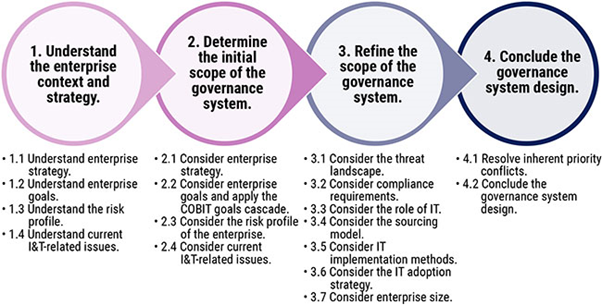COBIT 2019 vs COBIT 5: What's The Difference?


COBIT is an IT management framework designed to help organizations yield significant value from their IT initiatives while managing the underlying risks. Unlike most IT frameworks, COBIT offers a specific perspective—how to better secure and govern your assets to reduce risk.
In the years since 2012, when COBIT 5 debuted, the enterprise IT landscape has changed dramatically. A greater emphasis on security, risk management, and governance is mandatory in today’s multi-cloud environments that scale rapidly in response to market changes. Released last year, COBIT 2019 aims to reshape this changed landscape. Let’s take a look at the differences between COBIT 5 and the new COBIT 2019.
Released in 2012, the COBIT 5 framework offered guidelines for improving enterprise governance and management as more organizations migrated mission-critical workloads to the cloud. COBIT 5 provided a narrow and unique set of guidelines applicable to organizations across all industries and remained as a standard for many years.
According to ISACA, the governing body of COBIT, the 2019 version of the framework offers the following updates:
The following sections outline the biggest changes in the latest COBIT framework:
Update coverage areas now include new processes applicable to projects, business information and global regulatory or compliance frameworks. While the Governance Objectives and Management Objectives follow the same classifications as before, new processes have been introduced (or updated from COBIT 5). Specifically, Manage Programs and Project component is split into Managed Programs and Managed Projects. Additionally, Monitor, Evaluate and Assess the System of Internal Control is now Managed System of Internal Control and Managed Assurance. This brings the total COBIT processes from 37 to 40.

With this concept of Focus Areas, COBIT aims to keep pace with the changing tech-business risk landscape. Certain governance topics now constitute the Focus Areas, which can be updated and modified based on end-user feedback, market trends, and research.
There’s no limitation as to how many Focus Areas can be incorporated into the COBIT framework. With this flexibility, organizations following the COBIT framework can manage risk provisions as they pursue disruptive digital transformation projects.
Every business organization faces a unique set of governance challenges. In COBIT 2019, the Design Factor concept aims to address this issue by allowing organizations of all verticals and sizes to establish their own custom governance mechanism. The new Design Factors can be categorized as:
This model is designed and updated to evaluate various risk management and governance mechanism, objectives, and strategies. COBIT Performance Management (CPM) was originally introduced to evaluate how the various components of the governance and risk management systems work collectively and align with the expected target levels of the organization. As a result, organizations can identify the changes necessary to enhance their governance capability maturity levels. ISACA recommends the following high-level activities to achieve this goal:
 Source: ISACA
Source: ISACAThe COBIT 2019 framework offers an elaborated conceptual model that uses both concepts and relationships within the framework as a Unified Modeling Language (UML) model. This allows organizations to maintain a governance framework design and use automation capabilities as available.
COBIT 2019 includes additional changes, updates, and removals. For instance:
Users may follow COBIT certification programs to obtain extensive knowledge, including COBIT Bridge, COBIT 2019 Foundation, or the COBIT 2019 Design and Implementation certification program. Finally, the COBIT 2019 Design Guide has been published to discuss the updates and new framework guidelines in detail.